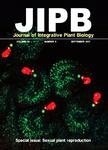Genetic Identification of Quantitative Trait Loci for Contents of Mineral Nutrients in Rice Grain
Genetic Identification of Quantitative Trait Loci for Contents of Mineral Nutrients in Rice Grain作者机构:Department of Plant Genetics and Breeding and State Key Laboratory of Plant Physiology and BiochemistryChina Agricultural University National Centre for Evaluation of Agricultural Wild Plant Rice Beijing Key Laboratory of Crop Genetic Improvement and Genome of Ministry of Agriculture
出 版 物:《Journal of Integrative Plant Biology》 (植物学报(英文版))
年 卷 期:2009年第51卷第1期
页 面:84-92页
核心收录:
基 金:Supported by the Project of Conservation and Utilization of AgriculturalWild Plants of the Ministry of Agriculture of China the National High-TechResearch and Development ("863") Program of China (2006AA100101) the National Natural Science Foundation of China (30771319)
主 题:introgression lines mineral elements Oryza sativa Oryza rufipogon quantitative trait loci.
摘 要:In present study, Fe, Zn, Mn, Cu, Ca, Mg, P and K contents of 85 introgression lines (ILs) derived from a cross between an elite indica cultivar Teqing and the wild rice (Oryza rufipogon) were measured by inductively coupled argon plasma (ICAP) spectrometry. Substantial variation was observed for all traits and most of the mineral elements were significantly positive correlated or independent except for Fe with Cu. A total of 31 putative quantitative trait loci (QTLs) were detected for these eight mineral elements by single point analysis. Wild rice (O. rufipogon) contributed favorable alleles for most of the QTLs (26 QTLs), and chromosomes 1,9 and 12 exhibited 14 QTLs (45%) for these traits. One major effect of QTL for zinc content accounted for the largest proportion of phenotypic variation (11%-19%) was detected near the simple sequence repeats marker RM152 on chromosome 8. The co-locations of QTLs for some mineral elements observed in this mapping population suggested the relationship was at a molecular level among these traits and could be helpful for simultaneous improvement of these traits in rice grain by marker assisted selection.



